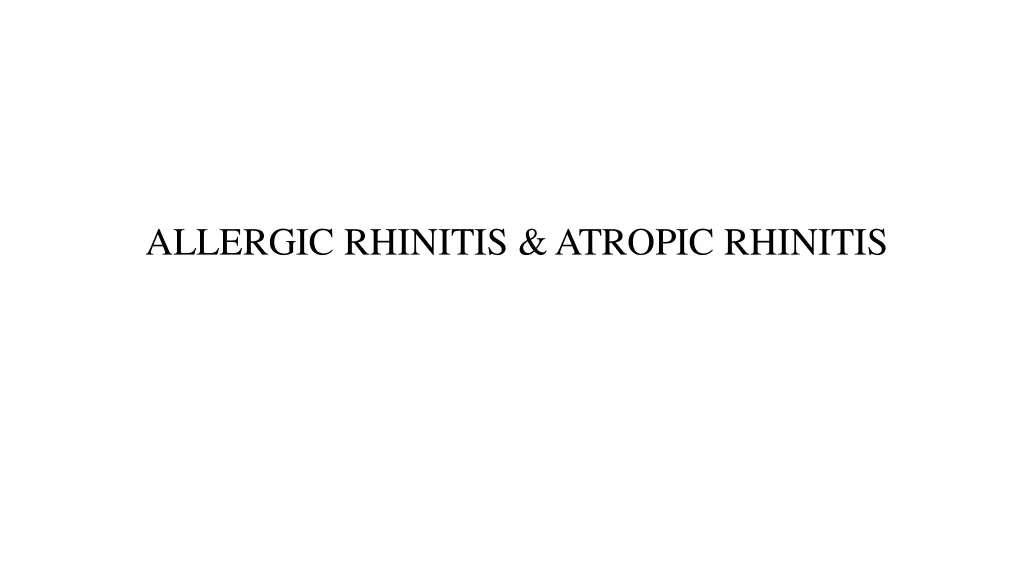
Chronic Inflammatory Rhinitis: Atrophic vs Allergic Rhinitis
Learn about atrophic rhinitis (ozaena) and allergic rhinitis, their causes, symptoms, complications, and treatments. Atrophic rhinitis is characterized by foul smell, nasal dryness, and anosmia, while allergic rhinitis is triggered by allergens causing sneezing and rhinorrhoea. Proper diagnosis and treatment are crucial to manage these conditions effectively.
Download Presentation

Please find below an Image/Link to download the presentation.
The content on the website is provided AS IS for your information and personal use only. It may not be sold, licensed, or shared on other websites without obtaining consent from the author. If you encounter any issues during the download, it is possible that the publisher has removed the file from their server.
You are allowed to download the files provided on this website for personal or commercial use, subject to the condition that they are used lawfully. All files are the property of their respective owners.
The content on the website is provided AS IS for your information and personal use only. It may not be sold, licensed, or shared on other websites without obtaining consent from the author.
E N D
Presentation Transcript
1)ATROPHIC RHINITIS (OZAENA) -This is a chronic inflammatory condition of the nose characterised by atrophic changes of the nasal mucosa and turbinates, expell foul smell from the nose and causes anosmia. -It may be primary or secondary to some other diseases. a)Primary atrophic Rhinitis :- Causative factors :- 1) Cocco bacillus of perez, Klebsiella foctidis ozaenae and diphtheroid organsisms etc. 2) Hereditary, Hormonal, Nutritional deficiencies vitamin deficiencies (A& D), Infection, Broad nasal cavities and due to other factors) b) SecondaryAtrophic Rhinitis :- Atrophic changes are produced due to chronic specific infections like syphilis, leprosy, lupus vulgaris, tuberculosis and Rhino scleroma; extensive Nasal surgery and chronic sinusitis etc
Pathology:- -As a result of chronic inflammatory changes the ciliated columnar epithelium of nasal cavity and turbinate atrophies and shows squamous metaplasia, blood circulation reduced, secretions stagnated and result in secondary infection and crust formation, due to loss of sensation and foetor attracts the flies (maggots) and patient looses the sense of smell. Clinical Features :- 1) Dryness in the nose 2)wide nasal cavities with crust formation. 3)The nose emits foul smell 4)Anosmia (merciful anosmia) the patient does feel his foul smell which is coming out and he doesn't smell the other thing also. 5) Head ache 6) Epistaxis 7) Atrophic changes in the mucosa ang bridge of the nose (due to atrophic changes.)
Complications :- 1) sinusitis 2) Middle ear infections. 3)Atrophic pharyngitis 4) Psychological Complications like depression and may become an introvert. Investigations :- 1) Xray for the detection 2) VDRLfor detecting syphilis.
3) Haemogram for detecting anaemia. 4) Dermotological examination for detecting Leprosy. 5) Nasal smear for detecting leprosy and tuberculosis. 6) Biopsy 7) Clinical findings. Treatment :- 1) The cause should be treated. 2) Improving the nasal hygiene by preventing the crusting by putting antibiotic nasal drops. alkaline douche, ex: nasal drops 25% glucose in glucerine, and by local infiltration of placental extract (Placentrex) etc. 3)Systemic antibiotics, nutrients, vitamins, vasodilators. 4)Surgical treatment .
2)ALLERGIC RHINITIS :- It is a common disorder which is usually characterised by spasmodic attacks of severe sneezing and rhinorrhoea, occurs due to altered reactivity, of the nasal mucosa to certain allergens like. a)Exogenous allergens:- Inhalants (dust pollens, animal odour, feathers, moulds, house dust and mites), ingestants (food like eggs, fish milk citrus fruits etc) Contactants (cosmetics and powders), irritants (fumes and smoke), drugs (aspirin, hypotensive drugs, iodides, and nasal drops), infections etc., b)Endogenous allergens :- Intestinal helminths, tissue proteins, etc. Predisposing factors :- a) Hereditary factors, b) Hormonal effects during puberty or pregnancy, c) climate - change in Humidity and atmospheric pollution d) Emotional factors etc.
Pathology :- -Antigen (allergen) + mucosa Histamines released, causes vasodilatation, increased capillary permeability, copious secretions from mucosal glands, leads to congestion oedema and swelling of mucosa, there is cellular infiltrations of mucosa by Eosinophils, plasma cells and lymphocystes -Because of oedema and swelling secondary bacterial infection occur, as the disease progresses there are chances for polyp formation in the nose and sinuses. -Other complications are serous otitis media, suppurative otitis media, Bronchial asthma etc.
Clinical Types;- 2 types are 1) Seasonal - Due to inhalant allergens, climate environmental changes 2) Perennial - affects through out the year. Signs & Symptoms :- Symptoms :- 1) Nasal irritation, paroxysmal sneezing, watery copious rhinorrhoea, nasal obstruction and anosmia.. Signs :- a)Acute stage: Pale nasal mucosa with excessive secretions b) Chronic stage: Bluish or purplish mucosa due to venous stasis. c) Infection: Secondary bacterial infection is added. d) Polyps:- may be present.
ConcomitantAllergy :- a) Eyes: Itching and watering of eyes is often present. b) Ears :- Eustachian tube blockage may leads to middle ear problems. c) Allergic Pharyngitis. d) Allergic bronchial asthma. Diagnosis :- 1) Clinical features & History 2) Nasal secretion may contain Eosinophils. 3) Haemogram shows Eosinophilia 4) Stools for helminths. 5) Intra dermal skin test, 6) Nasal provacation test. 7) Elimination test for food. 8) RAST(Radio allergo sorbent test)
Treatment :- 1) Avoidance of the allergen 2) Desensitization 3)Anti histamines 4) Steroids 5) Nasal decongestants. 6) Symptomatic treatment 7)Surgical correction of the predisposing diseases like deviated nasal septum, hypertrophied turbinate etc.






















